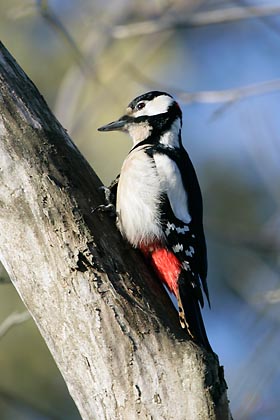Early spring of woodpeckers - great spotted woodpecker
Photo: Arne Ader
Translation: Liis
Great spotted woodpecker
Great spotted woodpecker Suur-kirjurähn
For spruces it is generally a poor cone year and because of this our woodpeckers have probably moved southwards in search of food. The great spotted woodpecker is our most numerous winterer, a passing migrant and of course also the best known woodpecker.
Occurs almost everywhere – in forests, wooded meadows, parks and gardens. It avoids well maintained and managed forests with good reason – there it would simply go hungry. Tree stands with old partly dried trees are good habitats for forest insects as well as their caterpillars and woodpeckers have plenty to do there ...
The great spotted woodpecker’s appearance is such that it is rather difficult to confuse it with another bird. Weight is a hundred grams at most, thus less than a third of the weight of the black woodpecker that was introduced earlier. Identifying it by the plumage is easy. Belly is off-white, without streaks, large oblong white patches on the shoulders; the area around the eyes and the cheeks are also white. The undertail area of all is red. But now take note:– the male has a small red spot at the nape, the female’s crown is wholly black, but the juveniles are characterized by a red crown. It is that simple – if you know and notice.
The presence of the great spotted woodpecker is often betrayed by a sharp "kik" call. The drumming is usually a brief and fast series of 6-7 knocks. So they announce the ownership of their territory to others; the neighbours as well as the females – that like to give notice of themselves – reply ... A thoroughly dried branch, thus well resounding, is sought out, or sometimes the iron roof of a house, or a wooden power post with an sheet iron cover at the top –drumming on these carries particularly far in an open area and surely boosts the ego of the drummer.
For nesting a new tree hollow is made each year; as a rule many hollows are made every year in the own territory. Of course this suits many hollow nesters, particularly if they don’t have such a chisel-like beak. It is still some months until nesting for the great spotted woodpecker.









